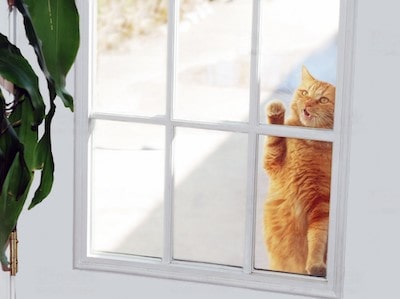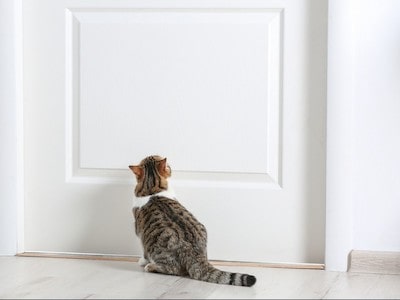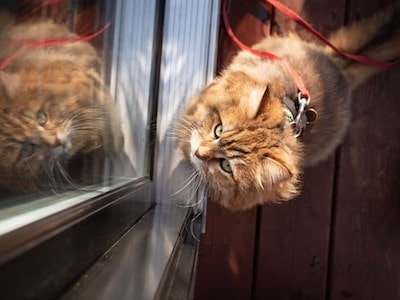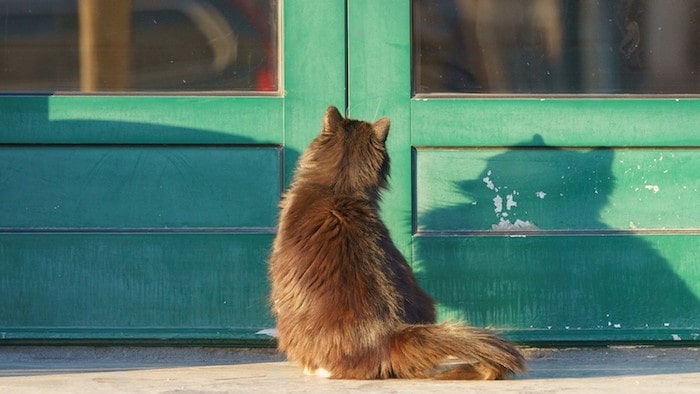Cats are known for their independent nature, but when they start meowing at your door, it can be a confusing and frustrating experience. As a cat owner or someone who loves cats, it’s important to understand why they meow at doors and what they’re trying to communicate.
This behavior can be due to a variety of reasons, ranging from seeking attention to expressing discomfort or anxiety. By understanding your cat’s behavior, you can establish routines and boundaries that promote their well-being and address any underlying health issues.
In this article, we will explore the reasons why cats meow at doors, how to understand your cat’s behavior, and strategies for dealing with unwanted meowing. So let’s get started, and see what our feline friends are trying to tell us!
Reasons Why Cats Meow at Doors
Cats are known for their expressive nature, and meowing at doors is one of the many ways they communicate with their humans. Here are some of the reasons why cats meow at doors:

- Seeking attention or affection: If you’ve been away from home for a while or if your cat is feeling lonely, cats are social animals and they crave attention from their human companions. Their way of saying “Hey, pay attention to me!” or “Come give me some love” is by meowing at the door. This behavior can be particularly common.
- Requesting food or treats: Your cat may be asking for food or treats if they meow at the door during mealtime or snack time. They are creatures of habit and may have learned that meowing at the door is an effective way to get what they want.
- Marking their territory: Cats have a territorial nature and may meow at doors to mark their territory, especially in households with more than one cat where they may compete for resources or dominance.
- Expressing discomfort or anxiety: If feeling uncomfortable or anxious, cats may meow at doors as a way of seeking comfort or reassurance from their owners. Moreover, during thunderstorms or when strangers are around, some cats may also meow at doors if they feel threatened or scared.
- Seeking shelter or warmth: Cats are known for their love of warm and cozy spots. If your cat is meowing at the door, it’s possible they’re trying to find a warm and safe place to curl up and nap.
- Seeking companionship or playtime: If cats are feeling bored or looking for a playmate, they may meow at doors because they are playful creatures. This behavior is particularly common in kittens or younger cats with a lot of energy to burn.
- Expressing displeasure or frustration: If cats are unhappy or annoyed, they can be moody creatures and may meow at doors. This is usually a way of expressing displeasure due to an unclean litter box or not liking certain foods.
- Exploring their environment: Exploring their environment, cats can meow at doors and this behavior is usually observed in young cats or those who are new to a household. Cats are naturally curious creatures.
Understanding Your Cat’s Behavior
Understanding your cat’s behavior is key to providing them with the appropriate care and attention they need. Here are some tips on how to understand your cat’s behavior:

- Observe body language and vocalizations: Cats communicate in a variety of ways, including through body language and vocalizations. By paying attention to your cat’s posture, tail position, and facial expressions, you can get a sense of their mood and feelings. Similarly, meows, purrs, and hisses can all convey different messages. For example, a loud and persistent meow might indicate hunger, while a low growl might signal aggression or fear.[1]
- Establish routines and boundaries: Cats thrive on routine and predictability. By establishing a regular feeding schedule, playtime routine, and sleep schedule, you can help your cat feel more comfortable and secure. Additionally, setting boundaries around certain behaviors, such as scratching furniture or jumping on counters, can help your cat understand what is and isn’t acceptable behavior.
- Provide appropriate outlets for behavior: Cats have natural instincts, such as scratching, hunting, and climbing. Providing appropriate outlets for these behaviors, such as scratching posts, toys, and cat trees, can help your cat feel fulfilled and happy. Additionally, providing plenty of playtime and interaction with your cat can help prevent boredom and destructive behavior.
- Address underlying health issues: Changes in your cat’s behavior or meowing patterns can be a sign of underlying health issues, such as pain or discomfort. If you notice any changes in your cat’s behavior, such as increased meowing or lethargy, it’s important to schedule a visit with your veterinarian to rule out any underlying health issues.
Dealing with Unwanted Meowing
While meowing is a normal and natural way for cats to communicate, excessive or unwanted meowing can be frustrating for owners. Here are some tips on how to deal with unwanted meowing[2]:

- Determine the cause: The first step in dealing with unwanted meowing is to determine the underlying cause. Is your cat meowing for attention, food, or affection? Are they feeling anxious or uncomfortable? By understanding the reason behind the meowing, you can take steps to address the underlying issue.
- Provide adequate stimulation: Boredom and lack of stimulation can be a common cause of excessive meowing. Providing your cat with plenty of toys, scratching posts, and playtime can help prevent boredom and destructive behavior.
- Ignore attention-seeking behavior: If your cat is meowing for attention, it’s important not to reward the behavior. Instead of giving in to their demands, wait until they are quiet and calm before giving them attention.
- Set boundaries: If your cat is meowing to demand food or treats, it’s important to set boundaries around mealtime and snacks. Stick to a regular feeding schedule and avoid giving in to demands for extra treats or food.
- Provide a comfortable and safe environment: Cats may meow if they’re feeling anxious or uncomfortable in their environment. Providing a safe and comfortable space for your cat to relax, such as a cozy bed or a secluded corner, can help them feel more secure and reduce excessive meowing.
- Consult with a veterinarian: If your cat’s meowing is sudden or excessive, it’s important to consult with a veterinarian to rule out any underlying health issues. Certain medical conditions, such as hyperthyroidism or kidney disease, can cause changes in behavior and meowing patterns.
FAQs
Can meowing at doors be a sign of anxiety or stress in cats?
Yes, excessive or persistent meowing at doors can be a sign of anxiety or stress in cats. It’s important to provide a comfortable and safe environment for your cat and consult with a veterinarian if you notice any changes in their behavior or meowing patterns.
Can cats meow at doors to mark their territory?
While meowing is not typically used by cats to mark their territory, they may scratch or rub their scent glands against the door to mark it as their territory.
Can training my cat reduce unwanted meowing at doors?
Yes, training your cat using positive reinforcement techniques can help reduce unwanted meowing at doors. Teaching your cat to come when called or rewarding quiet behavior can help them understand what behavior is expected of them. It’s important to be patient and consistent with training and avoid punishment-based techniques.
Can spaying or neutering my cat reduce excessive meowing?
Yes, spaying or neutering your cat can reduce excessive meowing related to hormonal changes, such as calling for a mate or marking territory. It’s important to consult with a veterinarian to determine the best time for spaying or neutering and to discuss any potential risks or benefits.
Conclusion
In conclusion, meowing at doors is a common behavior exhibited by cats for a variety of reasons, including seeking attention, food, or shelter, socializing, marking their territory, or due to anxiety or stress. Understanding your cat’s behavior and vocalizations can help determine the underlying cause of their meowing and allow you to provide appropriate care and attention.
Providing a comfortable and safe environment, setting boundaries, and training your cat using positive reinforcement techniques can help prevent unwanted meowing at doors. If you notice any changes in your cat’s behavior or meowing patterns, it’s important to consult with a veterinarian to rule out any underlying health issues.
With patience and understanding, you can build a strong bond with your feline companion and ensure their health and happiness.






